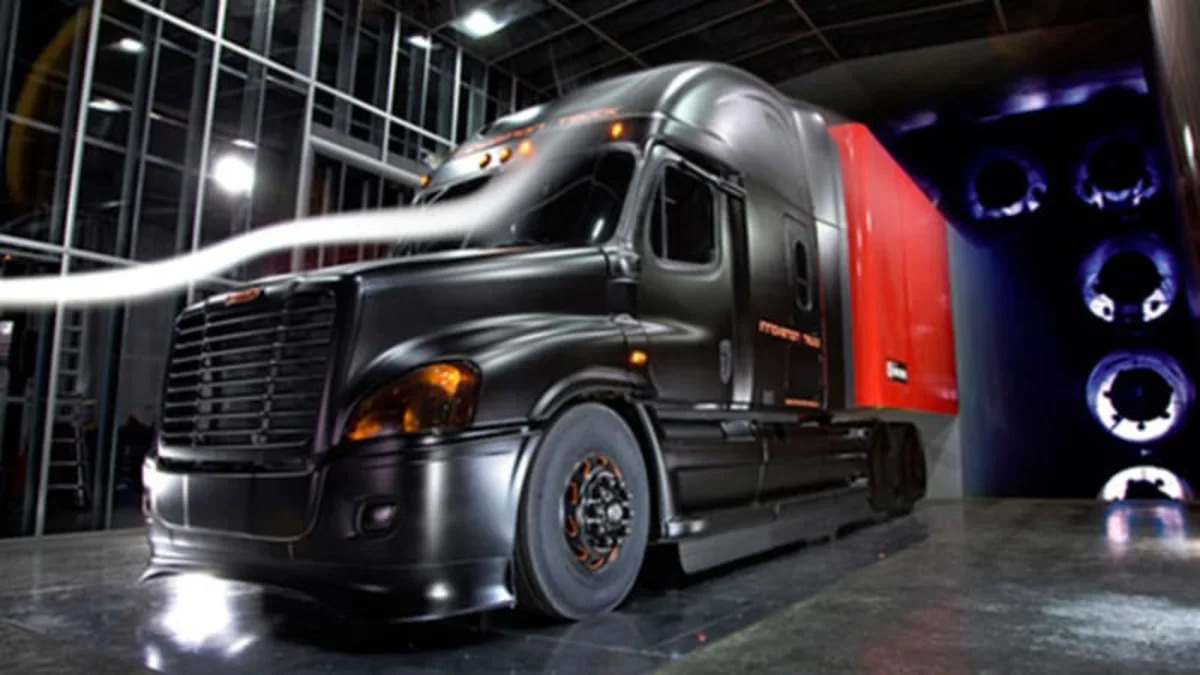Freightliner Innovation Truck - Click above for high-res image gallery
According to the American Trucking Association, there has been a 41 percent increase in registered large trucks and an 84 percent increase in miles traveled by large trucks from 1986 to 2006. That equals lots of diesel fuel consumed. Fortunately, a new report from Coordinating Research Council and the Health Effects Institute shows that pollution from heavy trucks and buses is actually improving at a faster rate than automobiles.
Impressively, today's big rig engines produce 98 percent less carbon monoxide, 10 percent less nitrogen oxide, 95 percent less non-methane hydrocarbons and 89 percent less particulate matter than required by EPA's 2007 diesel engine emission standards. Diesel engines manufactured in 2010 will perform even better as new regulations mean the powerplants will cut nitrogen oxide emissions by another 50 percent.
This study is the first installment of the Advanced Collaborative Emissions Study (ACES), which will continue to test diesel engines and the related health effects of burning diesel fuel over the next five years. Click here to view the official test results and to keep future tabs on the testing results.
[Source: American Trucking Association]
PRESS RELEASE:
Study Shows Dramatic Reductions in Diesel Engine Emissions
ARLINGTON, Va., June 23 /PRNewswire-USNewswire/ -- A new study shows that clean diesel technologies in engines manufactured beginning in 2007 not only reduced certain emissions by 90 percent over 2004 models, but far exceeded expectations in their performance in cleaning up the nation's air quality.
Emission reductions by 2007 model engines "exceeded substantially even those levels required by law," said the study, conducted by the Coordinating Research Council and the Health Effects Institute. Current engine models produced 98 percent less carbon monoxide, 10 percent less nitrogen oxide, 95 percent less non-methane hydrocarbons and 89 percent less particulate matter than required by EPA's 2007 diesel engine emission standards.
"These latest emissions figures are a testament to the trucking and engine manufacturing industries' deep commitment to the environment," said ATA President and CEO Bill Graves. "We're proud of the significant progress that has been made, and we look forward to building upon this foundation as we continue to work toward a more sustainable future."
Exceeding the 2007 standards marks a major milestone in clean diesel technology, and new engines built to 2010 standards will be even cleaner, slashing nitrogen oxide emissions by another 50 percent.
In addition to reducing emissions through clean diesel technologies, the trucking industry's progressive environmental sustainability program will reduce fuel consumption by 86 billion gallons and CO2 emissions by 900 million tons for all vehicles over the next 10 years by: setting governors on post-1992 trucks to limit speeds to no more than 65 mph; enacting a national speed limit of 65 mph for all vehicles; reducing engine idling; reducing congestion by improving highways; using more productive truck combinations; supporting national fuel economy standards for trucks; and increasing fuel efficiency by encouraging participation in the U.S. EPA SmartWay(SM) Transport Partnership program.
"Diesel engines are the workhorses of the nation's transportation infrastructure because they are fuel efficient, durable and reliable," said Jed Mandel, President of the Engine Manufacturers Association. "We can now add near-zero emissions to the list of diesel's positive attributes."
The study, sponsored by a multi-party group of government and industry organizations including the U.S. Department of Energy, the U.S. Environmental Protection Agency, the California Air Resources Board and the Engine Manufacturers Association, is phase 1 of the Advanced Collaborative Emissions Study (ACES). This five year, comprehensive emissions testing program will test the emissions and health effects of new technology diesel engines to document the improvements that have been made and to ensure that there are no unintended emissions from these new technologies. The results of the ACES study can be found by visiting here.
For more information about ATA's sustainability plan, visit www.trucksdeliver.org.


Sign in to post
Please sign in to leave a comment.
Continue